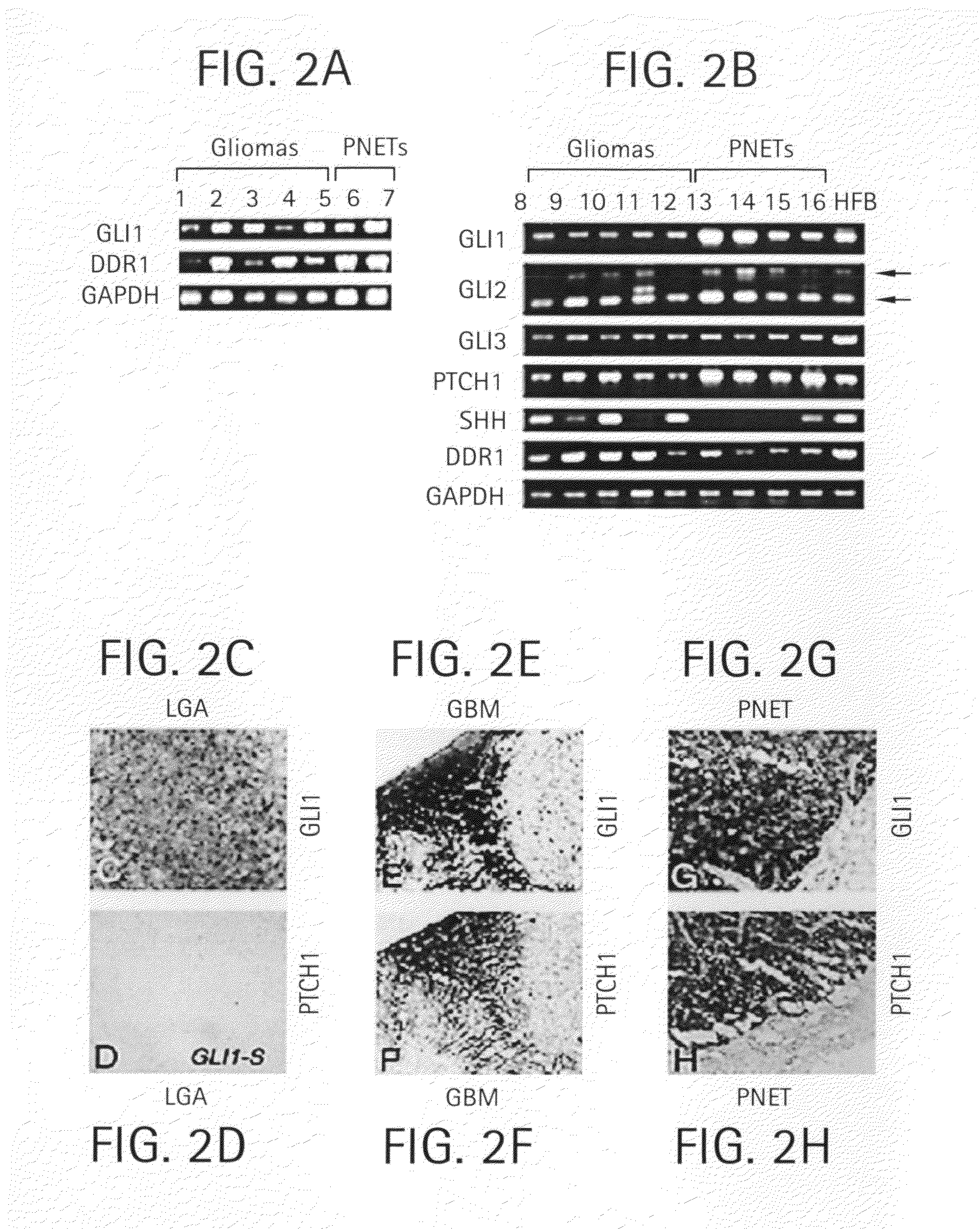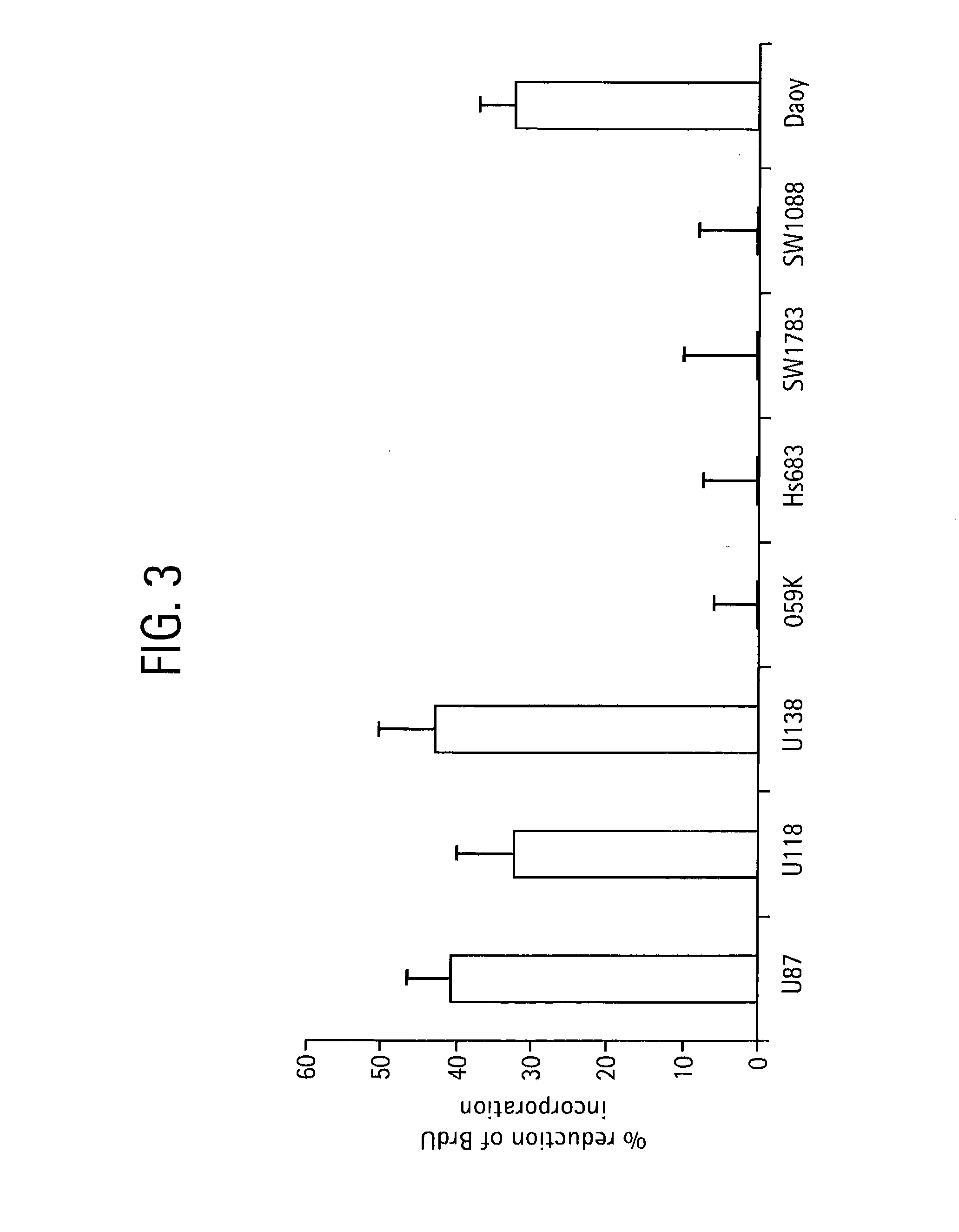Method and compositions for inhibiting tumorigenesis
a tumorigenesis and composition technology, applied in the field of pathology diagnosis and treatment, can solve the problems of inability to accurately distinguish aggressive prostate cancers, inability to accurately diagnose prostate cancer, and inability to achieve accurate prognostic tests or effective methods, so as to prevent the tumorigenic effect of the shh/gli pathway, promote the generation of adult neuronal cells, and promote tumorigenesis.
- Summary
- Abstract
- Description
- Claims
- Application Information
AI Technical Summary
Benefits of technology
Problems solved by technology
Method used
Image
Examples
specific embodiments
[0316]As shown below the inventors have not only examined the role of GLI proteins in carcinogenesis, in particular prostate cancer, but have explored the effects of Gli1 on apoptosis induced by various chemotherapeutic agents. The inventors have provided evidence to support a role for GLI in tumorigenesis and tumor cell proliferation and more importantly from a clinical point of view, in resistance to cell killing by cancer chemotherapeutic agents.
example 1
SHH-GLI Signaling and Tumorigenesis
[0318]Animals
[0319]Swiss-Webster mice were used unless otherwise specified. The Shh (Chiang et al., (1996) Nature 383, 407-413), Gli1 (Park et al., (2000) Development 127, 1593-1605) and Gli2 (Mo et al., (1997) Development 124, 113-123.) mutants from our colony were in this background. Cortical explants were prepared as previously described (Dahmane et al., (2001) Development 128, 5201-5212) and treated for 48 h. Anti-SHH antibodies were used at 4 μg / ml (University of Iowa Hybridoma Bank). Octyl-modified SHH-N protein was a kind gift from Ontogeny / Curis Inc. Human tumor samples were derived from the operating room or from the NYU tumor banks. Brain tumor cell lines were obtained from ATCC and grown according to its specifications. GL261 was a kind gift of Dr D. Zagzag. Frog (Xenopus laevis) embryos were obtained, reared and staged by standard methods. Tadpoles were ˜2 days old. All statistical analyses were carried out using the Student's t test an...
example 2
Inhibition of Prostate Cancer by Interference with Sonic Hedgehog-Gli1 Signaling
Materials and Methods
Cell Lines and Primary Cultures
[0350]The PC3, LNCaP and DU145 cell lines (Stone, K. R., Mickey, D. D., Wunderli, H., Mickey, G. H. & Paulson, D. F. (1978) Int. J. Cancer 21, 274-281 (1978); Kaighn, M. E., Lechner J. F., Narayan K. S. & Jones L. W. (1978) Natl. Cancer Inst. Monogr. 49, 17-21; Horoszewicz, J. S., Leong, S. S., Chu, T. M., Wajsman, Z. L., Friedman, M., Papsidero, L., Kim, U., Chai, L. S., Kakati, S., Arya, S. K. & Sandberg, A. A. (1980) Prog. Clin. Biol. Res. 37, 115-132) were purchased from ATCC and grown as specified. All primary prostate tumors were obtained following approved protocols. Tumors in PBS were chopped with a razor blade and incubated with Papain for 1 h at 37 degrees, they were then dissociated by passing them through a fire polished pipette and washed several times in serum containing media. All dissociated primary tumors were plated in polyornithin-lam...
PUM
| Property | Measurement | Unit |
|---|---|---|
| molecular weight | aaaaa | aaaaa |
| molecular weight | aaaaa | aaaaa |
| temperature | aaaaa | aaaaa |
Abstract
Description
Claims
Application Information
 Login to View More
Login to View More - R&D
- Intellectual Property
- Life Sciences
- Materials
- Tech Scout
- Unparalleled Data Quality
- Higher Quality Content
- 60% Fewer Hallucinations
Browse by: Latest US Patents, China's latest patents, Technical Efficacy Thesaurus, Application Domain, Technology Topic, Popular Technical Reports.
© 2025 PatSnap. All rights reserved.Legal|Privacy policy|Modern Slavery Act Transparency Statement|Sitemap|About US| Contact US: help@patsnap.com



